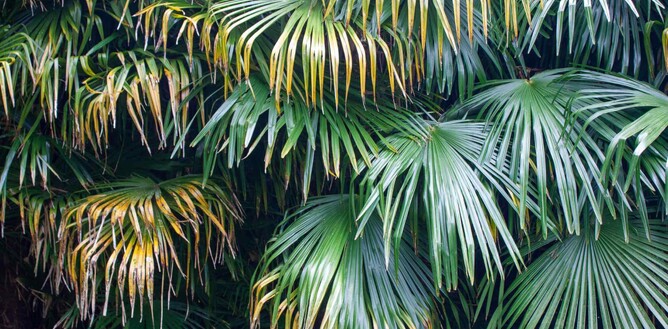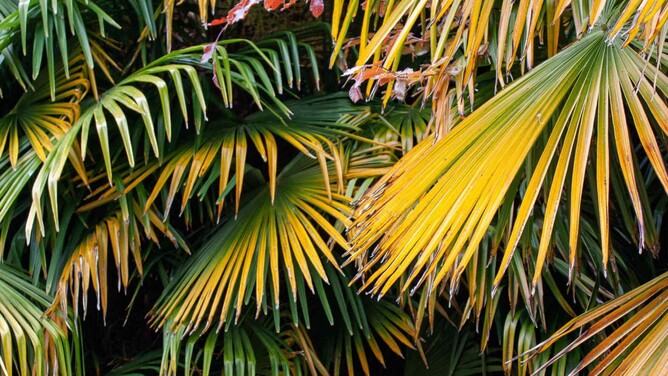Palm trees are an excellent feature for our homes, streets and natural spaces. They are low maintenance, remind many of us of tropical vacations and add an atmosphere of relaxation.
There are many palm species to choose from, small to tall, native to the introduced palms. For this reason, make sure you select the best tree for your garden so it can thrive. Too often, we see palm trees planted in the wrong location in someone’s garden or isn’t cared for properly.
Learn everything you need to know about palm trees in New Zealand, from care basics to our only native palm tree to expert advice.
Nikau Palm, New Zealand Native Palm Tree
Many palm trees have been introduced to New Zealand over the years displaying in our streets, houses and land. However, Nikau palm, Rhopalostylis sapida, is the only native palm species to New Zealand.
The palm can reach 10 to 15 metres high, and its fronds can expand to three metres in length. It can take 20 years for a young nikau palm to develop a trunk. Some of the tallest palms, 10 metres tall, can be very old, maybe around 200 years. Nikau palm is found in North and South Island, in coastal and lowland areas.
The native tree was significant to Māori life. They used the leaves as weatherproof thatch and cladding for houses; they would wrap food and weave the fronds into hats, mats and baskets.
Today, human development, land clearing, and mammal introduction have directly impacted this native plant. Their habitat has been reduced. In addition, mammals have been eating their flowers and fruits, so fewer plants are produced.
Where To Start?
Why do you want to plant a palm tree? To create shade around the swimming pool, add a nice feature in the house entrance or make you feel on vacation? The reasons are infinite. Just make sure you know your goals first.
As for many other plants, it’s essential to choose the correct palm tree for your garden. Think about the size, location and sunlight. Some palm trees can grow tall quickly, so plan before planting. Ensure your soil has good drainage.
We recommend planting in Spring at the start of the growing season. Using mulch around the base of the palm will help the soil retain moisture and keep the weeds out.
Basic Care Of Palm Trees
1. Watering
During the growing months, palm trees must receive enough water and have good drainage. However, be careful not to overpour because still water can damage the roots.
Every palm species is different, so make sure to adapt your watering to each one.
2. Weeding
For young palms, we recommend hand weeding. As they grow, we suggest keeping weeds at least a metre from the trunk of a palm. Adding mulch around the tree will help control weeds if you want low maintenance. Mulch also retains the moisture in the ground and provides food for the plant.
3. Pruning
We recommend pruning once a year to remove old leaves and help new leaves thrive. It is a natural thing for lower leaves to start browning. It is essential to prune your palm trees to remove dead fronds, avoid damage, increase light and prevent rodent infestation.
Look at your palm trees now and assess the situation. Then, contact our team for advice and book a quote.
4. Pest Prevention
New Zealand is very lucky as it has few pests that can cause severe damage to palm trees. Scale insects and mealybugs are the only things that can affect them.
5. Fertilising
Slow-release fertiliser is best since it works better and is the safest. Apply in small amounts during spring, summer and early autumn. Apply around the tree and not too close to the trunk. Do not over-fertilise. This can be very harmful to the tree.
Arborist Expert Advice
Over the years, our team have pruned and removed many palm trees in the Waikato. We have compiled a few tips and tricks to help you choose the best palm and be on the lookout when the tree matures.
Queen palms, King palms and Fan palms often have insufficient roots for their size and weight when mature, so we recommend wobbling them once in a while. If a big one moves around, we usually recommend supporting it with stakes or removing the tree for safety concerns. In addition, high winds could cause the tree to fall and damage your property.
Furthermore, we recommend not putting a weed mat around the base because the roots won’t penetrate the mat. Instead, they will grow along the top of it, causing a fragile root plate.
When shopping for a palm tree, keep the following in mind. Queen palms are fast-growing, King palms become very tall (10-12m), and nikau palms are slow-growing and need very moist soil. All palms are different, so be aware of how they grow and the space you need.
Palm trees are a great addition to your home and our growing cities. Nevertheless, planning is essential as it will minimise harm to the tree in the future.
At Marc Doyle Treework, our experienced arborist teams have the equipment and techniques to perform palm tree pruning and removal services with ease and safety in mind.
Contact our team today for more information, advice and a free quote.




